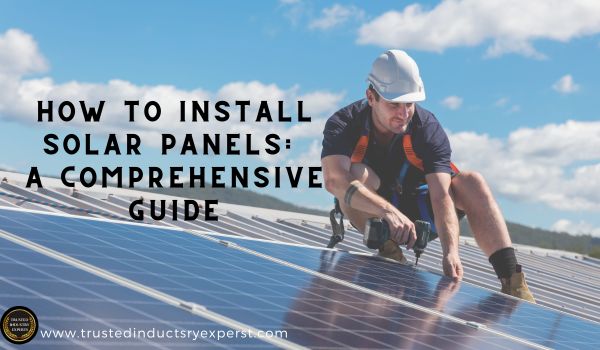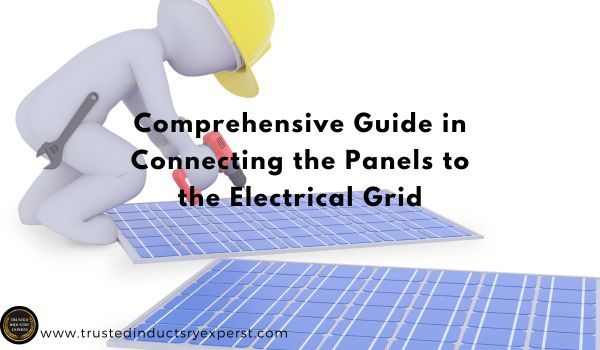
How to Install Solar Panels: A Comprehensive Guide
Installing a solar panel system is an important step in harnessing renewable energy. The solar panel installation process is not overly complicated, but it does require time and dedication to ensure that each component of the system is correctly installed. Researching the various components necessary for the installation – such as mounting hardware, inverters, safety equipment, and wiring – can be a great way to get started on the project. Hiring a professional installer with experience and training in solar panel installations can also help streamline the entire process. By choosing certified energy practitioners to install a solar system now, you will have access to clean, reliable energy for years to come!
Once the solar panel system is installed, homeowners may be eligible for a federal solar tax credit that could cover up to 30% of the total cost. Additionally, there are many financing options available such as solar loans or zero-down lease and purchase programs that can make solar panel installation more affordable. Some states even offer specific incentives for installing solar panel systems such as reduced rates for connected customers. Finally, if electricity storage is desired, homeowners can look into adding solar batteries to take advantage of the excess energy generated by the panels and store it for later use.
Installing solar panels is a great way to reduce energy costs and support sustainable living. With advances in technology and decreasing costs, solar energy has become a more accessible option for households and businesses.
Comprehensive Guide in Connecting the Panels to the Electrical Grid

This will walk you through the process of installing solar panels, from assessing your energy needs to connecting the panels to the electrical grid.
Installing solar equipment is becoming increasingly common as advancements in solar technology continue to improve. New solar panels allow for increased efficiency and cost savings, as well as greater sustainability. Solar cells are the basic units which make up a solar battery bank and they can be easily connected to existing electrical grids. The cost of having new solar panels installed will vary depending on the size of the system, but that initial investment can often be offset by long-term savings on energy costs. With recent improvements in solar technology, these savings have increased significantly making these systems even more beneficial for homes and businesses alike.
Installing solar panels can provide many environmental benefits, such as reducing CO2 emissions and increasing energy independence. For maximum efficiency, it is important to have the system installed by experienced professionals who are trained in safety protocols. Local installers are often more knowledgeable about the specific codes and regulations for your area and can provide valuable advice for selecting roof mounts and battery backup systems. Additionally, installation costs can vary based on the size of the system, but there are also incentives available to help offset some of these costs.
Assess Your Surplus Energy Needs
DIY solar panel installation is becoming increasingly popular for homeowners who want to save money and reduce their environmental impact. If you are interested in taking on the project yourself, start by researching the components necessary for installation and making sure you have all of the safety equipment required. There are detailed online resources that provide step-by-step instruction for DIY solar panel installation. However, it is highly recommended to hire a certified solar installer or work with reputable solar companies to ensure that your system is installed correctly. Solar installers will also be able to provide any additional services such as connecting the system to the electrical grid, installing batteries, and fully integrating it into your home energy system. Taking these steps will help you maximize clean energy savings and have peace of mind knowing that your system was installed safely and efficiently.
The first step in installing solar panels is to assess your energy needs. This will help determine the size and number of panels needed for your home or business. You can start by reviewing your electricity bill to get an idea of your average energy consumption.
Next, consider the orientation and shading of your roof. The panels should be installed in an area that receives the most sunlight to maximize energy production. If there are trees or other structures blocking the sun, they may need to be trimmed or removed to allow for optimal panel performance.
Choose the Right Solar Panel System
After you have assessed your energy needs and found the optimal location for your solar panels, it’s time to choose the right solar panel system. A comprehensive solar panel installation guide will help you select the appropriate components and determine how much power you need. Solar electricity is a great way to reduce energy efficient costs and create clean, renewable energy.
Home solar power systems
After you have assessed your energy needs and found the optimal location for your solar panels, it’s time to choose the right solar panel system. There are several options available, including federal solar tax credits, solar leases, and purchasing outright. The cost of installing a solar panel system can vary greatly depending on the size of the system and the quality of components used. Working with a reputable solar company or installer can help ensure that you get the best value for your investment. Additionally, many companies offer financing solutions or solar leases which can help reduce upfront costs and make owning a system more affordable.
When considering different types of systems, it is important to consider how much energy you will be able to generate with it and how much money you will save on energy bills over time. A comprehensive system design should also include an assessment of available space as well as any local codes or regulations that need to be taken into account. Photovoltaic (PV) systems are generally considered the most efficient type of solar panel system due to their high-efficiency performance rates and long lifespans. However, there are other types of systems that may be more suitable for certain applications such as off-grid systems or portable systems. Regardless of which type you choose, all systems require thorough design and proper installation in order to ensure optimal performance.
They can range from small, portable units to large-scale solar panel installations that provide enough electricity for an entire home. Solar panel installation involves mounting the panels securely on the roof or in an open area with direct sunlight. Once installed, wiring must be connected between each component of the system including the inverter and battery storage. It is important to ensure that all wiring meets local electrical codes and safety standards before connecting to your home’s existing electrical appliances.
Once you have assessed your energy needs, you can choose the right solar panel system. There are several factors to consider when choosing a solar panel system, including efficiency, cost, and durability.
It is important to choose a high-quality, efficient panel system from a reputable manufacturer. Look for a warranty that covers the panels for at least 25 years. This will ensure that your investment is protected for the long term.
Install the Solar Panels
Once you have chosen the right home solar power system for your needs, you need to consider how many solar panels will be necessary. Depending on the size of your home and the amount of energy you use, you may need anywhere from a few panels to dozens. In addition, it is important to research any federal solar tax credits or other incentives available in your area. These can provide significant savings on the cost of installation and maintenance. Lastly, if you are unable to purchase a panel system outright, you may want to consider a power purchase agreement with the most solar panels provider. This is an attractive option for those who want to make the switch to renewable energy but are unable to make a large upfront investment. A PPA allows homeowners to buy electricity from their local solar provider at discounted rates, often saving them money over time.
After you have chosen the right solar panel system, you can start installing the panels. The installation process typically involves mounting the panels to your roof, connecting the wiring, and setting up the inverter.
It is important to follow all local building codes and safety regulations when installing the panels. If you are not experienced in electrical panel work, it is recommended to hire a professional installer to ensure the job is done correctly.
Connect to the Electrical Grid
Once all of the components are installed, it is time to connect the solar panel system to the electric grid. Solar array leases and other renewable energy contracts can help offset the upfront costs of installation, allowing homeowners to begin producing clean electricity quickly. The solar installation process will then involve connecting the electrical wiring from the panels to the main power line, as well as any solar battery or storage systems that are part of your solar energy system. It is important that all components are connected properly so that they operate efficiently and safely on the electric grid. With a professional installer completing these steps, you can be sure that your solar panel system will produce reliable electricity for years to come.
The final step in installing solar panels is to connect them to the electrical grid. This allows excess energy produced by the panels to be fed back into the grid and credited to your account.
Before connecting to the grid, you will need to obtain all necessary permits and approvals from your local utility company. A professional electrician can assist you in this process and ensure that the connection is done safely and in accordance with all local regulations.
Solar installations are great investment in both energy savings and sustainable living. With a little research and preparation, anyone can successfully install solar panels and enjoy the benefits of clean, renewable energy.
By following this comprehensive guide, you can confidently install solar panels and start taking advantage of clean, renewable energy.



